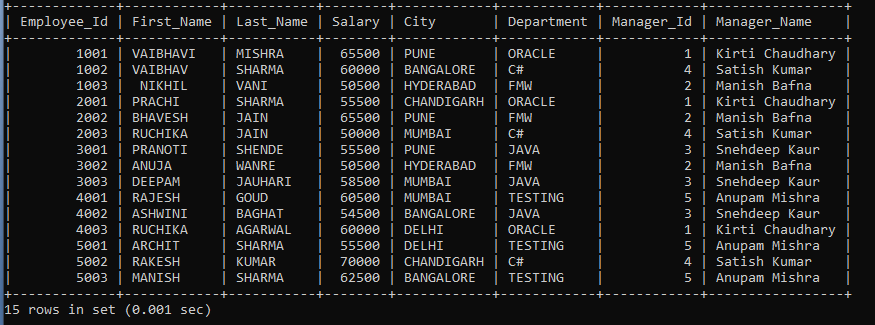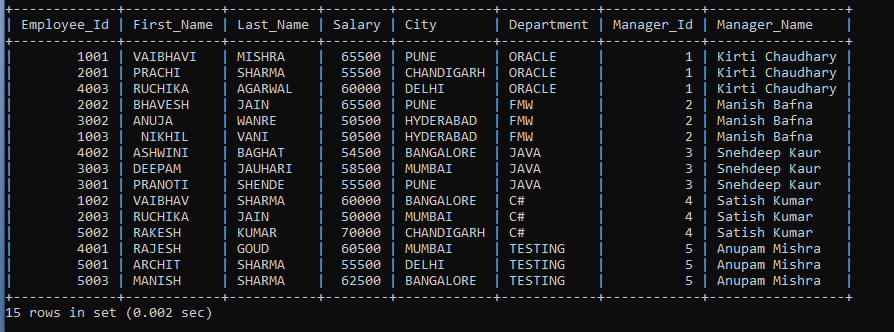SQL Inner Join
In Structured Query Language, the most used join query is the Inner join query.
Inner join query retrieves the records from one or more tables with similar data or records. The joins condition returns only common rows between the tables.
Inner Join is one of the types of joins in the Structured Query Language Join.
Suppose we have two tables, Table A and Table B. Table A have some columns, and Table B also has some columns. How joining will happen between these two-columns? In this case, there is one common column between these two tables. So joining will be met through this common column.
Syntax of Inner Join in SQL:
SELECT COLUMNNAME1, COLUMNNAME2, COLUMNNAME3, COLUMNNAME4 FROM TABLE1 INNER JOIN TABLE2 ON TABLE1.COLUMN NAME = TABLE2.COLUMN NAME;
Example of Inner Join in Structured Query Language:
Consider these tables to understand the Inner Join concept.
Table 1: Employees:
| EMPLOYEE_ID | FIRST_NAME | LAST_NAME | SALARY | CITY | DEPARTMENT | MANAGERID |
| 1001 | VAIBHAVI | MISHRA | 65500 | PUNE | ORACLE | 1 |
| 1002 | VAIBHAV | SHARMA | 60000 | BANGALORE | C# | 4 |
| 1003 | NIKHIL | VANI | 50500 | HYDERABAD | FMW | 2 |
| 2001 | PRACHI | SHARMA | 55500 | CHANDIGARH | ORACLE | 1 |
| 2002 | BHAVESH | JAIN | 65500 | PUNE | FMW | 2 |
| 2003 | RUCHIKA | JAIN | 50000 | MUMBAI | C# | 4 |
| 3001 | PRANOTI | SHENDE | 55500 | PUNE | JAVA | 3 |
| 3002 | ANUJA | WANRE | 50500 | HYDERABAD | FMW | 2 |
| 3003 | DEEPAM | JAUHARI | 58500 | MUMBAI | JAVA | 3 |
| 4001 | RAJESH | GOUD | 60500 | MUMBAI | TESTING | 5 |
| 4002 | ASHWINI | BAGHAT | 54500 | BANGALORE | JAVA | 3 |
| 4003 | RUCHIKA | AGARWAL | 60000 | DELHI | ORACLE | 1 |
| 5001 | ARCHIT | SHARMA | 55500 | DELHI | TESTING | 5 |
| 5002 | RAKESH | KUMAR | 70000 | CHANDIGARH | C# | 4 |
| 5003 | MANISH | SHARMA | 62500 | BANGALORE | TESTING | 5 |
Table 2: Manager.
| Manager_Id | Manager_Name | Manager_Department |
| 1 | Kirti Chaudhary | ORACLE |
| 2 | Manish Bafna | FMW |
| 3 | Snehdeep Kaur | JAVA |
| 4 | Satish Kumar | C# |
| 5 | Anupam Mishra | TESTING |
Example 1: Execute an inner join query on the employee and manager table name.
SELECT Employee_Id, First_Name, Last_Name, Salary, City, Department, M.Manager_Id, Manager_Name FROM Employees E INNER JOIN Manager M ON E.Manager_Id = M.Manager_Id;
The above Inner join query joins the employees' table and manager table and retrieves the data from the tables where E.Manager_Id = M.Manager_Id.
The output of the above query is as follows:
| EMPLOYEE_ID | FIRST_NAME | LAST_NAME | SALARY | CITY | DEPARTMENT | MANAGER_ID | MANAGER_NAME |
| 1001 | VAIBHAVI | MISHRA | 65500 | PUNE | ORACLE | 1 | Kirti Chaudhary |
| 1002 | VAIBHAV | SHARMA | 60000 | BANGALORE | C# | 4 | Satish Kumar |
| 1003 | NIKHIL | VANI | 50500 | HYDERABAD | FMW | 2 | Manish Bafna |
| 2001 | PRACHI | SHARMA | 55500 | CHANDIGARH | ORACLE | 1 | Kirti Chaudhary |
| 2002 | BHAVESH | JAIN | 65500 | PUNE | FMW | 2 | Manish Bafna |
| 2003 | RUCHIKA | JAIN | 50000 | MUMBAI | C# | 4 | Satish Kumar |
| 3001 | PRANOTI | SHENDE | 55500 | PUNE | JAVA | 3 | Snehdeep Kaur |
| 3002 | ANUJA | WANRE | 50500 | HYDERABAD | FMW | 2 | Manish Bafna |
| 3003 | DEEPAM | JAUHARI | 58500 | MUMBAI | JAVA | 3 | Snehdeep Kaur |
| 4001 | RAJESH | GOUD | 60500 | MUMBAI | TESTING | 5 | Anupam Mishra |
| 4002 | ASHWINI | BAGHAT | 54500 | BANGALORE | JAVA | 3 | Snehdeep Kaur |
| 4003 | RUCHIKA | AGARWAL | 60000 | DELHI | ORACLE | 1 | Kirti Chaudhary |
| 5001 | ARCHIT | SHARMA | 55500 | DELHI | TESTING | 5 | Anupam Mishra |
| 5002 | RAKESH | KUMAR | 70000 | CHANDIGARH | C# | 4 | Satish Kumar |
| 5003 | MANISH | SHARMA | 62500 | BANGALORE | TESTING | 5 | Anupam Mishra |

Example 2: Execute an inner join query on table name Employees and Manager using order by clause.
SELECT Employee_Id, First_Name, Last_Name, Salary, City, Department, M.Manager_Id, Manager_Name FROM Employees E INNER JOIN Manager M ON E.Manager_Id = M.Manager_Id ORDER BY Manager_Id;
The above inner join query joins the two tables named Employees Table and Manager Table and retrieves the data from both the tables where E.MANAGER_ID = M.MANAGER_ID. The employees' records will be displayed in the ascending order by Manager_Id as we have used the ORDER BY clause in the query. The query will display only similar records between the two tables.
The output of the above query is as follows:
| EMPLOYEE_ID | FIRST_NAME | LAST_NAME | SALARY | CITY | DEPARTMENT | MANAGER_ID | MANAGER_NAME |
| 1001 | VAIBHAVI | MISHRA | 65500 | PUNE | ORACLE | 1 | Kirti Chaudhary |
| 2001 | PRACHI | SHARMA | 55500 | CHANDIGARH | ORACLE | 1 | Kirti Chaudhary |
| 4003 | RUCHIKA | AGARWAL | 60000 | DELHI | ORACLE | 1 | Kirti Chaudhary |
| 2002 | BHAVESH | JAIN | 65500 | PUNE | FMW | 2 | Manish Bafna |
| 3002 | ANUJA | WANRE | 50500 | HYDERABAD | FMW | 2 | Manish Bafna |
| 1003 | NIKHIL | VANI | 50500 | HYDERABAD | FMW | 2 | Manish Bafna |
| 4002 | ASHWINI | BAGHAT | 54500 | BANGALORE | JAVA | 3 | Snehdeep Kaur |
| 3003 | DEEPAM | JAUHARI | 58500 | MUMBAI | JAVA | 3 | Snehdeep Kaur |
| 3001 | PRANOTI | SHENDE | 55500 | PUNE | JAVA | 3 | Snehdeep Kaur |
| 2003 | RUCHIKA | JAIN | 50000 | MUMBAI | C# | 4 | Satish Kumar |
| 5002 | RAKESH | KUMAR | 70000 | CHANDIGARH | C# | 4 | Satish Kumar |
| 1002 | VAIBHAV | SHARMA | 60000 | BANGALORE | C# | 4 | Satish Kumar |
| 5001 | ARCHIT | SHARMA | 55500 | DELHI | TESTING | 5 | Anupam Mishra |
| 5003 | MANISH | SHARMA | 62500 | BANGALORE | TESTING | 5 | Anupam Mishra |
| 4001 | RAJESH | GOUD | 60500 | MUMBAI | TESTING | 5 | Anupam Mishra |

Example 3: Execute an inner join query on table name Employees and Manager using group by clause.
SELECT Employee_Id, First_Name, Last_Name, Salary, City, Department, M.Manager_Id, Manager_Name FROM Employees E INNER JOIN Manager M ON E.Manager_Id = M.Manager_Id GROUP By Salary;
The above inner join query joins the two Employees Table and Manager Table and retrieves the data from the tables where E.MANAGER_ID = M.MANAGER_ID. The data is displayed in the GROUP BY employee salary. Employees with the same salary will be in a group with one salary. Employees who don't have the same salary number as another employee's salary, will have separate salary group.
The output of the above query is as follows:
| EMPLOYEE_ID | FIRST_NAME | LAST_NAME | SALARY | CITY | DEPARTMENT | MANAGER_ID | MANAGER_NAME |
| 2003 | RUCHIKA | JAIN | 50000 | MUMBAI | C# | 4 | Satish Kumar |
| 1003 | NIKHIL | VANI | 50500 | HYDERABAD | FMW | 2 | Manish Bafna |
| 4002 | ASHWINI | BAGHAT | 54500 | BANGALORE | JAVA | 3 | Snehdeep Kaur |
| 2001 | PRACHI | SHARMA | 55500 | CHANDIGARH | ORACLE | 1 | Kirti Chaudhary |
| 3003 | DEEPAM | JAUHARI | 58500 | MUMBAI | JAVA | 3 | Snehdeep Kaur |
| 1002 | VAIBHAV | SHARMA | 60000 | BANGALORE | C# | 4 | Satish Kumar |
| 4001 | RAJESH | GOUD | 60500 | MUMBAI | TESTING | 5 | Anupam Mishra |
| 5003 | MANISH | SHARMA | 62500 | BANGALORE | TESTING | 5 | Anupam Mishra |
| 1001 | VAIBHAVI | MISHRA | 65500 | PUNE | ORACLE | 1 | Kirti Chaudhary |
| 5002 | RAKESH | KUMAR | 70000 | CHANDIGARH | C# | 4 | Satish Kumar |

Example 4: Execute an inner join query on table name Employees and Manager using where clause.
SELECT Employee_Id, First_Name, Last_Name, Salary, City, Department, M.Manager_Id, Manager_Name FROM Employees E INNER JOIN Manager M ON E.Manager_Id = M.Manager_Id WHERE Salary > 52000;
The above inner join query joins the two Employees Table and Manager Table and retrieves the data from the tables where E.MANAGER_ID = M.MANAGER_ID. The query will display only employee's data where the employee salary is greater than 52000.
The output of the above query is as follows:
| EMPLOYEE_ID | FIRST_NAME | LAST_NAME | SALARY | CITY | DEPARTMENT | MANAGER_ID | MANAGER_NAME |
| 1001 | VAIBHAVI | MISHRA | 65500 | PUNE | ORACLE | 1 | Kirti Chaudhary |
| 1002 | VAIBHAV | SHARMA | 60000 | BANGALORE | C# | 4 | Satish Kumar |
| 2001 | PRACHI | SHARMA | 55500 | CHANDIGARH | ORACLE | 1 | Kirti Chaudhary |
| 2002 | BHAVESH | JAIN | 65500 | PUNE | FMW | 2 | Manish Bafna |
| 3001 | PRANOTI | SHENDE | 55500 | PUNE | JAVA | 3 | Snehdeep Kaur |
| 3003 | DEEPAM | JAUHARI | 58500 | MUMBAI | JAVA | 3 | Snehdeep Kaur |
| 4001 | RAJESH | GOUD | 60500 | MUMBAI | TESTING | 5 | Anupam Mishra |
| 4002 | ASHWINI | BAGHAT | 54500 | BANGALORE | JAVA | 3 | Snehdeep Kaur |
| 4003 | RUCHIKA | AGARWAL | 60000 | DELHI | ORACLE | 1 | Kirti Chaudhary |
| 5001 | ARCHIT | SHARMA | 55500 | DELHI | TESTING | 5 | Anupam Mishra |
| 5002 | RAKESH | KUMAR | 70000 | CHANDIGARH | C# | 4 | Satish Kumar |
| 5003 | MANISH | SHARMA | 62500 | BANGALORE | TESTING | 5 | Anupam Mishra |
